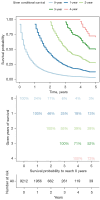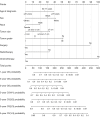Brain metastases in newly diagnosed lung cancer: epidemiology and conditional survival
- PMID: 39524997
- PMCID: PMC11543091
- DOI: 10.21037/tcr-24-776
Brain metastases in newly diagnosed lung cancer: epidemiology and conditional survival
Abstract
Background: The brain serves as the primary site for metastasis in patients with both non-small cell lung cancer (NSCLC) and small cell lung cancer (SCLC). The presence of lung cancer with brain metastasis (LCBM) is a debilitating condition associated with considerable morbidity and mortality. The objective of this study was to assess the incidence and survival rates of LCBM in the United States population.
Methods: We analyzed a total of 9,212 patients diagnosed with LCBM between 2010 and 2015, extracted from the Surveillance, Epidemiology, and End Results (SEER) database. Our analysis assessed the incidence, relative survival, and conditional survival (CS) of LCBM. We utilized the Kaplan-Meier method to estimate overall survival and determine CS at year y+x after x years of survival, following the formula CS(y|x) = CS(y+x)/CS(x). Prognostic factor selection was performed using the least absolute shrinkage and selection operator (LASSO) regression approach, and multivariate Cox regression was employed to demonstrate the impact of these predictors on outcomes and construct a CS-based nomogram.
Results: The overall age-adjusted incidence rate of LCBM was 5.82 cases per 100,000, with a slight decline observed during our study period. Patient relative survival showed a continuous decline with increasing age. CS analysis revealed that the 5-year CS rate for patients initially diagnosed with LCBM adjusted from 3% to 13%, 28%, 52%, and 73% over successive years of survival (1-4 years). Identified predictors included age at diagnosis, sex, race, tumor size, tumor grade, surgery, radiotherapy, and chemotherapy. These predictors, along with the CS formula, were employed to develop a CS-based nomogram for real-time prognosis prediction. Calibration curve, area under the time-dependent receiver operating characteristic (ROC) curve, concordance index (c-index), and decision curve analysis (DCA) demonstrated the model's strong predictive capabilities.
Conclusions: This study deepened our understanding of LCBM patients, summarizing their epidemiological characteristics and CS patterns. We successfully developed a novel CS-based nomogram model for dynamic survival estimation, offering real-time and personalized prognostic information that is clinically valuable.
Keywords: Lung cancer with brain metastasis (LCBM); Surveillance, Epidemiology, and End Results (SEER); incidence; nomogram; survival.
2024 AME Publishing Company. All rights reserved.
Conflict of interest statement
Conflicts of Interest: Both authors have completed the ICMJE uniform disclosure form (available at https://tcr.amegroups.com/article/view/10.21037/tcr-24-776/coif). The authors have no conflicts of interest to declare.
Figures







Similar articles
-
Conditional survival analysis and real-time prognosis prediction for cervical cancer patients below the age of 65 years.Front Oncol. 2023 Jan 9;12:1049531. doi: 10.3389/fonc.2022.1049531. eCollection 2022. Front Oncol. 2023. PMID: 36698403 Free PMC article.
-
Conditional survival nomogram predicting real-time prognosis of locally advanced breast cancer: Analysis of population-based cohort with external validation.Front Public Health. 2022 Oct 31;10:953992. doi: 10.3389/fpubh.2022.953992. eCollection 2022. Front Public Health. 2022. PMID: 36388300 Free PMC article.
-
Construction and validation of a novel web-based nomogram for patients with lung cancer with bone metastasis: A real-world analysis based on the SEER database.Front Oncol. 2022 Dec 9;12:1075217. doi: 10.3389/fonc.2022.1075217. eCollection 2022. Front Oncol. 2022. PMID: 36568214 Free PMC article.
-
Analysis of prognostic factors of metastatic endometrial cancer based on surveillance, epidemiology, and end results database.Front Surg. 2023 Jan 6;9:1001791. doi: 10.3389/fsurg.2022.1001791. eCollection 2022. Front Surg. 2023. PMID: 36684133 Free PMC article. Review.
-
Refining Lung Cancer Brain Metastasis Models for Spatiotemporal Dynamic Research and Personalized Therapy.Cancers (Basel). 2025 May 7;17(9):1588. doi: 10.3390/cancers17091588. Cancers (Basel). 2025. PMID: 40361513 Free PMC article. Review.
Cited by
-
Reirradiation using helical tomotherapy-based hypofractionated stereotactic radiotherapy for 19 brain metastases after the second recurrence of distant brain failure: a case report and literature review.Transl Lung Cancer Res. 2025 Jan 24;14(1):272-286. doi: 10.21037/tlcr-2024-1151. Epub 2025 Jan 22. Transl Lung Cancer Res. 2025. PMID: 39958210 Free PMC article.
-
Significance of Platinum-Based Chemotherapy With Programmed Death-1 Blockade in Limited Disease Small Cell Lung Cancer: A Retrospective Study.Thorac Cancer. 2025 Jul;16(13):e70118. doi: 10.1111/1759-7714.70118. Thorac Cancer. 2025. PMID: 40583736 Free PMC article.
References
LinkOut - more resources
Full Text Sources
